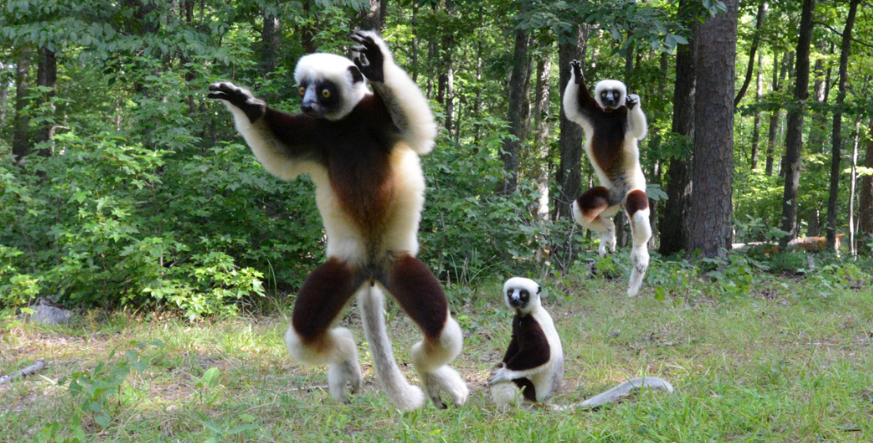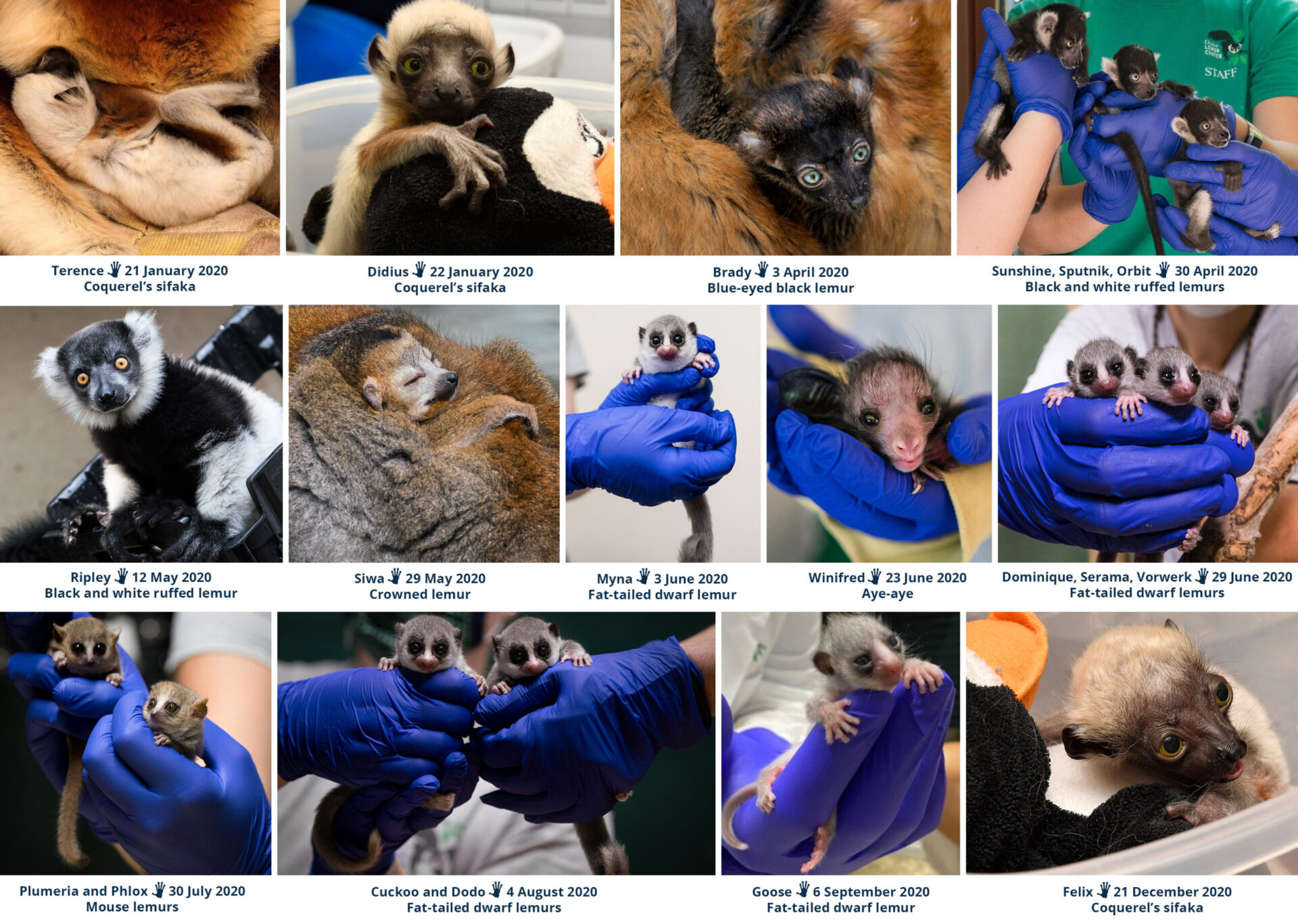Colony Management and Conservation Breeding: 2020 Impact Report

A trio of Coquerel’s sifakas free-ranges at the DLC.
Managing a colony of the planet’s most endangered mammals is challenging in the best of times. Not only do we care for 15 species of primates, each with unique, specialized diets and behaviors, but we are always learning new things and adapting our approaches for the best possible care of them. Lemurs are highly social creatures with a multitude of individual idiosyncrasies. Add to that the challenges to protect our colony and staff from infection from COVID-19, and you can only begin to imagine what 2020 was like for our animal care team.
Here’s a perfect example of “our colony plan versus reality” in 2020:
The problem: The Coquerel’s sifaka, a unique and highly sensitive prosimian, is cared for at twelve institutions accredited by the Association of Zoos and Aquariums (AZA) in the United States. Outside of Madagascar, no other country has this species in captivity. There are only 66 Coquerel’s sifakas living in the U.S., and the DLC holds half of them right here in Durham. While the DLC specializes in lemur care, it is not ideal to have such a delicate population all in one place in the event of a stochastic event, such as a disease, which could render the DLC population at risk. We are a critical genetic safety net for this species, so addressing this issue is a priority for us.
A solution: In an effort to give this species a better chance for long term survival in captivity, the Species Survival Program (SSP) for Coquerel’s sifaka has spent the last three years developing a plan to establish a breeding program outside of the U.S. After exploring many options, we settled on four European zoos. We trained their staff on the finer details of sifaka health and husbandry, and selected the best individual candidates (genetically appropriate) to leave the DLC and begin their important roles at new zoo homes in Europe. Then, we began the arduous process of applying for all of the required permits for transferring endangered species to the other countries. Note that it is optimal to move the animals in the spring or early summer when the sifakas need to adjust to new varieties of fresh browse (plants/trees/leaves) that are vital for their survival. These animals are obligate folivores and cannot thrive without a daily dose of eating leaves.
The challenge: While all of this preparation began in 2019, we are still working on it in 2021. Why? Just as the transportation permits were submitted for travel in 2019, we faced a government shutdown and our window of opportunity was lost for transferring the animals to Europe. Given that delay, we once again applied for the required permits for travel in early 2020. However, the outbreak of COVID-19 halted all shipments of primates out of the U.S., and into Europe. Here we are, close to the spring of 2021, and we are at it again, crossing our fingers that our small window of travel and the endangered species permits come together in time for it to happen this year. We are still waiting for those permits, and time is of the essence.
Dedication to Exemplary Primate Care
We have continued to face and adapt to many challenges in 2020 due to the unprecedented threat of COVID-19. Our staff immediately adjusted to wearing masks and gloves on the grounds, well ahead of the North Carolina state mandate. Staffing schedules were rearranged in order to reduce the risk of transmission. Our DLC staff were split into teams with shifts to reduce time overlapping onsite. The Center was immediately closed, and research projects, public tours, volunteer hours, and internship programs were cancelled.
Despite these significant changes, remarkable things happened. Everyone pitched in with animal care. Everyone. Whether dishes needed washing, fruit needed chopping, or cages needed cleaning, the DLC team, regardless of department, made sure that the lemurs had excellent daily care. It was truly a testament to the dedication that the staff has to these animals and to the DLC mission. It was a beautiful thing to be a part of, like a well-oiled machine. I was proud of our team, even more than usual, and that is saying something.
Conservation Breeding

In 2020, the Duke Lemur Center celebrated the births of 19 infants representing seven different species. Click the image for a larger view.
Life itself does not stand still or wait for normalcy. Our colony has continued to express itself, and since the pandemic arrived, we have some new arrivals for which we are very thankful. Last summer, we had seven dwarf lemurs join our nocturnal colony, along with two mouse lemurs, each a minuscule 10g in weight. Small and mighty they are! A baby aye-aye was a fantastic addition, as was a baby crowned lemur, a blue-eyed black lemur, and four black and white ruffed lemurs. This spring, we have had some sifaka births, too. The offspring success rate of this species is not much better than 50%, so we wait cautiously for these infants to thrive. Our colony stands at 205 animals, but not for long, as ultrasounds are confirming pregnant females of several species for this year’s birth seasons. It is very exciting. Radio calls from the vets announcing who is pregnant, and with how many, are always followed by shouts of joy all around.
An important part of our work is collaborating with other AZA institutions to pair lemurs who provide optimal genetic outcomes for their species—a lemur “dating service,” if you will. As part of this important work, transferring animals between zoos and the DLC is an expected part of our work. Since early 2020, airline policies have been extremely strict (or non-existent) when shipping animals during this time, and we have been driving with animals long distances. The lemur world has to keep spinning, and when the best genetically paired mate is somewhere else, we pull out all the stops to get them to that first date.
In 2020, we had a few animals transfer to other zoos and some new DLC arrivals: ring-tailed, Coquerel’s sifaka, and blue-eyed black lemurs departed for other institutions; and ring-tailed, red ruffed, and mouse lemurs arrived. When our animals leave for another location, it is melancholy for us as we will miss them; but we know they will be starting their own families elsewhere. Incoming “newbies” are always fun to meet.
New Curatorial Team
There is a new curatorial team in place here at the DLC, and together we are looking at ways to build upon our already robust program of giving the lemurs their best lives within human care. Even though I have worked at the Center for the past thirteen years, my new role as Colony Curator is an exciting one, and I am inspired by those who built this colony before me.
We have the opportunity to grow appropriately-sized family groups for our social species, where possible. Lemurs rely on their family bonds for protection and stability, and equally importantly for psychological wellbeing. Spring is here, which means warmer temperatures for animals to go back out into the woods and be enriched by the forests of North Carolina. We have a robust breeding program with our small nocturnal lemurs, and are the only institution in this country with a breeding colony of dwarf lemurs. It is such a shame, as these animals are fantastically animated, with big personalities and beautiful eyes. They also do something so unique for a primate, and that is they torpor, living off of the fat in their tails for months while they shut down most other bodily functions. Absolutely fascinating!
We are thankful to the many other DLC staff and technician assistant volunteers who contribute significantly toward the DLC’s exceptional care of our colony.
We hope to share more joyous and unique experiences with all of you soon, as it has been very quiet without public visitors and tours at the Center for the last year. We hope that you and your families are thriving, despite the potential challenges that still lay ahead.

